Research on Random Drift Model Identification and Error Compensation Method of MEMS Sensor Based on EEMD-GRNN
Abstract
:1. Introduction
2. GRNN Structure and Parameter Optimization Algorithm
2.1. The Structure of GRNN
2.1.1. Input Layer
2.1.2. Mode Layer
2.1.3. Summation Layer
2.1.4. Output Layer
2.2. GRNN Parameter Optimization Algorithm
3. White Noise Separation Method Based on EEMD
3.1. Influence of White Noise on Neural Network Modeling
3.2. EEMD Introduction and Principle of Signal Decomposition
3.3. Separation Method of White Noise
4. Application of EEMD-GRNN Algorithm
White Noise Separation Method Based on EEMD
5. Recognition Method of Denoising Signal
5.1. Moeling Method Based on GA-BP
5.2. Modeling Method Based on GRNN
6. Acceleration-Based Displacement Measurement Experiment
6.1. Design of Acceleration Acquisition System
6.2. Displacement Measurement Method Based on Acceleration Integral
6.3. Measurement Error Analysis
6.4. Experiment
7. Discussion and Conclusions
- Due to the unreasonable setting of input and output samples of neural network, the existence of noise will affect the modeling effect of neural network.
- According to the characteristic of EEMD with binary filter, white noise can be separated from the original signal.
- Neural network has better modeling effect for denoised signals.
- The best GRNN model based on cross validation and parameter optimization algorithm has better fitting effect on complex nonlinear drift signals than BP neural network.
- If the output error of the acceleration sensor participates in the integration process, it will be gradually amplified in the integration process.
- The error compensation algorithm based on EEMD-GRNN can compensate the sensor output error to a certain extent. The low requirement for the raw output data of the sensor is also an advantage of this algorithm compared with other compensation algorithms.
- Different sensors have different drift characteristics. The drift process of some sensors is more intense, while the drift process of other sensors is more gentle.
Author Contributions
Funding
Institutional Review Board Statement
Informed Consent Statement
Data Availability Statement
Conflicts of Interest
References
- Metni, N.; Pflimlin, J.M.; Hamel, T.; Souères, P. Attitude and gyro bias estimation for a VTOL UAV. Control. Eng. Pract. 2006, 14, 1511–1520. [Google Scholar] [CrossRef]
- Kim, S.-G.; Lee, E.; Hong, I.-P.; Yook, J.-G. Review of Intentional Electromagnetic Interference on UAV Sensor Modules and Experimental Study. Sensors 2022, 22, 2384. [Google Scholar] [CrossRef] [PubMed]
- Berg, G.V. Integrated velocity and displacement of strong earthquake ground motion. Bull. Seismol. Soc. Am. 1961, 51, 175–189. [Google Scholar] [CrossRef]
- Iyer, B.; Patil, N. IoT enabled tracking and monitoring sensor for military applications. Int. J. Syst. Assur. Eng. Manag. 2018, 9, 1294–1301. [Google Scholar] [CrossRef]
- Cox, S.M.; Lane, A.; Volchenboum, S.L. Use of Wearable, Mobile, and Sensor Technology in Cancer Clinical Trials. JCO Clin. Cancer Inform. 2018, 2, 1–11. [Google Scholar] [CrossRef]
- Jin, T.; Sun, Z.; Li, L.; Zhang, Q.; Zhu, M.; Zhang, Z.; Yuan, G.; Chen, T.; Tian, Y.; Hou, X.; et al. Triboelectric nanogenerator sensors for soft robotics aiming at digital twin applications. Nat. Commun. 2020, 11, 5381. [Google Scholar] [CrossRef]
- Yunas, J.; Mulyanti, B.; Hamidah, I.; Mohd Said, M.; Pawinanto, R.E.; Wan Ali, W.A.F.; Subandi, A.; Hamzah, A.A.; Latif, R.; Yeop Majlis, B. Polymer-Based MEMS Electromagnetic Actuator for Biomedical Application: A Review. Polymers 2020, 12, 1184. [Google Scholar] [CrossRef]
- Saylan, Y.; Akgönüllü, S.; Yavuz, H.; Ünal, S.; Denizli, A. Molecularly Imprinted Polymer Based Sensors for Medical Applications. Sensors 2019, 19, 1279. [Google Scholar] [CrossRef] [Green Version]
- D’Alessandro, A.; Scudero, S.; Vitale, G. A Review of the Capacitive MEMS for Seismology. Sensors 2019, 19, 3093. [Google Scholar] [CrossRef] [Green Version]
- Park, M.; Gao, Y. Error Analysis and Stochastic Modeling of Low-cost MEMS Accelerometer. J. Intell. Robot Syst. 2006, 46, 27–41. [Google Scholar] [CrossRef]
- Stiros, S.C. Errors in velocities and displacements deduced from accelerographs: An approach based on the theory of error propagation. Soil. Dyn. Earthq. Eng. 2008, 28, 415–420. [Google Scholar] [CrossRef]
- Xu, P. Error estimates of velocities and displacements from accelerographs. Geophys. J. Int. 2012, 3, 1061–1064. [Google Scholar] [CrossRef] [Green Version]
- Pang, G.; Liu, H. Evaluation of a Low-cost MEMS Accelerometer for Distance Measurement. J. Intell. Robot. Syst. 2001, 30, 249–265. [Google Scholar] [CrossRef]
- Han, S.; Meng, Z.; Omisore, O.; Akinyemi, T.; Yan, Y. Random Error Reduction Algorithms for MEMS Inertial Sensor Accuracy Improvement—A Review. Micromachines 2020, 11, 1021. [Google Scholar] [CrossRef]
- Shao, Z.; Lei, X.; Chen, D. A gyro drift error compensation algorithm for a small unmanned aerial vehicle system. In Proceedings of the International Conference on Networking, Sensing and Control, Okayama, Japan, 26–29 March 2009; pp. 817–822. [Google Scholar]
- Nikkhah, A.A.; Heydari, P.; Khaloozadeh, H.; Heydari, A.P. Gyroscope Random Drift Modeling, Using Neural Networks, Fuzzy Neural and Traditional Time-Series Methods. J. Aerosp. Sci. Technol. 2009, 6, 35–44. [Google Scholar]
- Ji, X.; Wang, S.; Xu, Y.; Shi, Q.; Xia, D. Application of the Digital Signal Procession in the MEMS Gyroscope De-drift. In Proceedings of the IEEE International Conference on Nano/Micro Engineered and Molecular Systems, Zhuhai, China, 18–21 January 2006; pp. 218–221. [Google Scholar]
- Ding, M.; Shi, Z.; Du, B.; Wang, H.; Han, L.; Cheng, Z. The method of MEMS gyroscope random error compensation based on ARMA. Meas. Sci. Technol. 2021, 59, 63–72. [Google Scholar] [CrossRef]
- Yong, S.; Chen, J.; Song, C.; Han, Y. Research on the compensation in MEMS gyroscope random drift based on time-series analysis and Kalman filtering. In Proceedings of the IEEE 2015 34th Chinese Control Conference (CCC), Hangzhou, China, 28–30 July 2015; pp. 2078–2082. [Google Scholar]
- Tu, Y.H.; Peng, C.C. An ARMA Based Digital Twin for MEMS Gyroscope Drift Dynamics Modeling and Real-Time Compensation. IEEE Sens. J. 2020, 21, 2712–2724. [Google Scholar] [CrossRef]
- Du, J.; Li, J. A Compensation Algorithnm for Zero Drifting Error of MEMS Gyroscope. In Proceedings of the 2016 5th International Conference on Measurement, Instrumentation and Automation (ICMIA 2016), Shenzhen, China, 17–18 September 2016; pp. 780–784. [Google Scholar]
- Ompusunggu, A.P.; Bey-Temsamani, A. 2-Level error (drift) compensation for low-cost MEMS-based inertial measurement unit (IMU). Microsyst. Technol. 2016, 22, 1601–1612. [Google Scholar] [CrossRef]
- Ruzza, G.; Guerriero, L.; Revellino, P.; Guadagno, F.M. Thermal Compensation of Low-Cost MEMS Accelerometers for Tilt Measurements. Sensors 2018, 18, 2536. [Google Scholar] [CrossRef] [Green Version]
- Fontanella, R.; Accardo, D.; Moriello, R.S.L.; Angrisani, L.; De Simone, D. MEMS gyros temperature calibration through artificial neural networks. Sens. Actuat. A Phys. 2018, 279, 553–565. [Google Scholar] [CrossRef]
- Ali, M. Compensation of temperature and acceleration effects on MEMS gyroscope. In Proceedings of the 13th International Bhurban Conference on Applied Sciences and Technology (IBCAST), Islamabad, Pakistan, 12–16 January 2016; pp. 274–279. [Google Scholar]
- Shiau, J.K.; Huang, C.X.; Chang, M.Y. Noise Characteristics of MEMS Gyro’s Null Drift and Temperature Compensation. J. Appl. Sci. Eng. 2012, 15, 239–246. [Google Scholar]
- Pawase, R.; Futane, N.P. Angular rate error compensation of MEMS based gyroscope using artificial neural network. In Proceedings of the 2015 International Conference on Pervasive Computing (ICPC), Pune, India, 8–10 January 2015; pp. 1–4. [Google Scholar]
- Zhu, R.; Zhang, Y.; Bao, Q. A novel intelligent strategy for improving measurement precision of FOG. IEEE T Instrum. Meas. 2000, 49, 1183–1188. [Google Scholar]
- Chen, X. Modeling random gyro drift by time series neural networks and by traditional method. In Proceedings of the 2003 International Conference on Neural Networks and Signal Processing, Nanjing, China, 14–17 December 2003; pp. 810–813. [Google Scholar]
- Fan, C.; Jin, Z.; Tian, W.; Qian, F. Temperature drift modelling of fibre optic gyroscopes based on a grey radial basis function neural network. Meas. Sci. Technol. 2004, 15, 119. [Google Scholar] [CrossRef]
- Hao, W.; Tian, W. Modeling the Random Drift of Micro-Machined Gyroscope with Neural Network. Neural. Process. Lett. 2005, 22, 235–247. [Google Scholar] [CrossRef]
- Yang, Y.; Cheng, X.; Ma, J.; Zhang, W. Thermally induced error and compensating in open-loop fiber optical gyroscope. In Proceedings of the Advanced Photonic Sensors: Technology & Applications, Beijing, China, 10 August 2000; pp. 77–81. [Google Scholar]
- Alaluev, R.V.; Ivanov, Y.V.; Malyutin, D.M.; Raspopov, V.Y.; Dmitriev, V.A.; Ermilov, S.P.; Ermilova, G.A. High-precision algorithmic compensation of temperature instability of accelerometer’s scaling factor. Autom. Remote Control 2011, 72, 853–860. [Google Scholar] [CrossRef]
- Lee, K., II; Takao, H.; Sawada, K.; Ishida, M. A three-axis accelerometer for high temperatures with low temperature dependence using a constant temperature control of SOI piezoresistors. In Proceedings of the Sixteenth Annual International Conference on Micro Electro Mechanical Systems, Kyoto, Japan, 23–23 January 2003; pp. 478–481. [Google Scholar]
- Lee, J.; Rhim, J. Temperature compensation method for the resonant frequency of a differential vibrating accelerometer using electrostatic stiffness control. J. Micromech. Microeng. 2012, 22, 95016–95026. [Google Scholar] [CrossRef]
- Li, Q.; Teng, J.; Wang, X.; Zhang, Y.; Quo, J. Research of gyro signal de-noising with stationary wavelets transform. In Proceedings of the CCECE 2003—Canadian Conference on Electrical and Computer Engineering, toward a Caring and Humane Technology (Cat. No.03CH37436), Montreal, QC, Canada, 4–7 May 2003; pp. 1989–1992. [Google Scholar]
- Liu, S.; Chen, G. Research on Noise Reduction Optimization of MEMS Gyroscope Based on Intelligent Technology. J. Phys. Conf. Series 2021, 1802, 022017. [Google Scholar] [CrossRef]
- Li, Z.; Fan, Q.; Chang, L.; Yang, X. Improved wavelet threshold denoising method for MEMS gyroscope. In Proceedings of the 11th IEEE International Conference on Control & Automation (ICCA), Taichung, Taiwan, 18–20 June 2014; pp. 530–534. [Google Scholar]
- Sheng, G.; Gao, G.; Zhang, B. Application of Improved Wavelet Thresholding Method and an RBF Network in the Error Compensating of an MEMS Gyroscope. Micromachines 2019, 10, 608. [Google Scholar] [CrossRef] [Green Version]
- Huang, N.E.; Shen, Z.; Long, S.R.; Wu, M.C.; Shih, H.H.; Zheng, Q.; Yen, N.-C.; Tung, C.C.; Liu, H.H. The empirical mode decomposition and the Hilbert spectrum for nonlinear and non-stationary time series analysis. Process. Roy. Soc. A Math Phy. 1998, 454, 903–995. [Google Scholar] [CrossRef]
- Wang, T.; Zhang, M.; Yu, Q.; Zhang, H. Comparing the applications of EMD and EEMD on time–frequency analysis of seismic signal. J. Appl. Geophys. 2012, 83, 29–34. [Google Scholar] [CrossRef]
- Lei, Y.; He, Z.; Zi, Y. Application of the EEMD method to rotor fault diagnosis of rotating machinery. Mech. Syst. Signal. Pract. 2009, 23, 1327–1338. [Google Scholar] [CrossRef]
- Specht, D.F. A general regression neural network. IEEE Trans. Neural. Networ. 1991, 2, 568–576. [Google Scholar] [CrossRef] [PubMed] [Green Version]
- Wu, Z.; Huang, N.E. Ensemble empirical mode decomposition: A noise-assisted data analysis method. Adv. Data Sci. Adapt. 2009, 1, 1–14. [Google Scholar] [CrossRef]
- Wu, Z.; Huang, N.E. A study of the characteristics of white noise using the empirical mode decomposition method. Process. Roy. Soc. A Math Phy. 2004, 460, 1597–1611. [Google Scholar] [CrossRef]
- Flandrin, P.; Rilling, G.; Goncalves, P. Empirical mode decomposition as a filter bank. IEEE Signal. Proc. Lett. 2004, 11, 112–114. [Google Scholar] [CrossRef] [Green Version]
- Ding, S.; Xu, X.; Zhu, H.; Wang, J.; Jin, F. Studies on Optimization Algorithms for Some Artificial Neural Networks Based on Genetic Algorithm (GA). J. Comput. 2011, 6, 939–946. [Google Scholar] [CrossRef]
- Zheng, W.; Dan, D.; Cheng, W.; Xia, Y. Real-time dynamic displacement monitoring with double integration of acceleration based on recursive least squares method. Measurement 2019, 141, 460–471. [Google Scholar] [CrossRef]
- Xu, L.; Fang, L.; Lin, C.; Guo, D.; Qi, Z.; Huo, R. Design of Distance Measuring System Based on MEMS Accelerometer. J. Electr. Eng. Technol. 2019, 14, 1675–1682. [Google Scholar] [CrossRef]
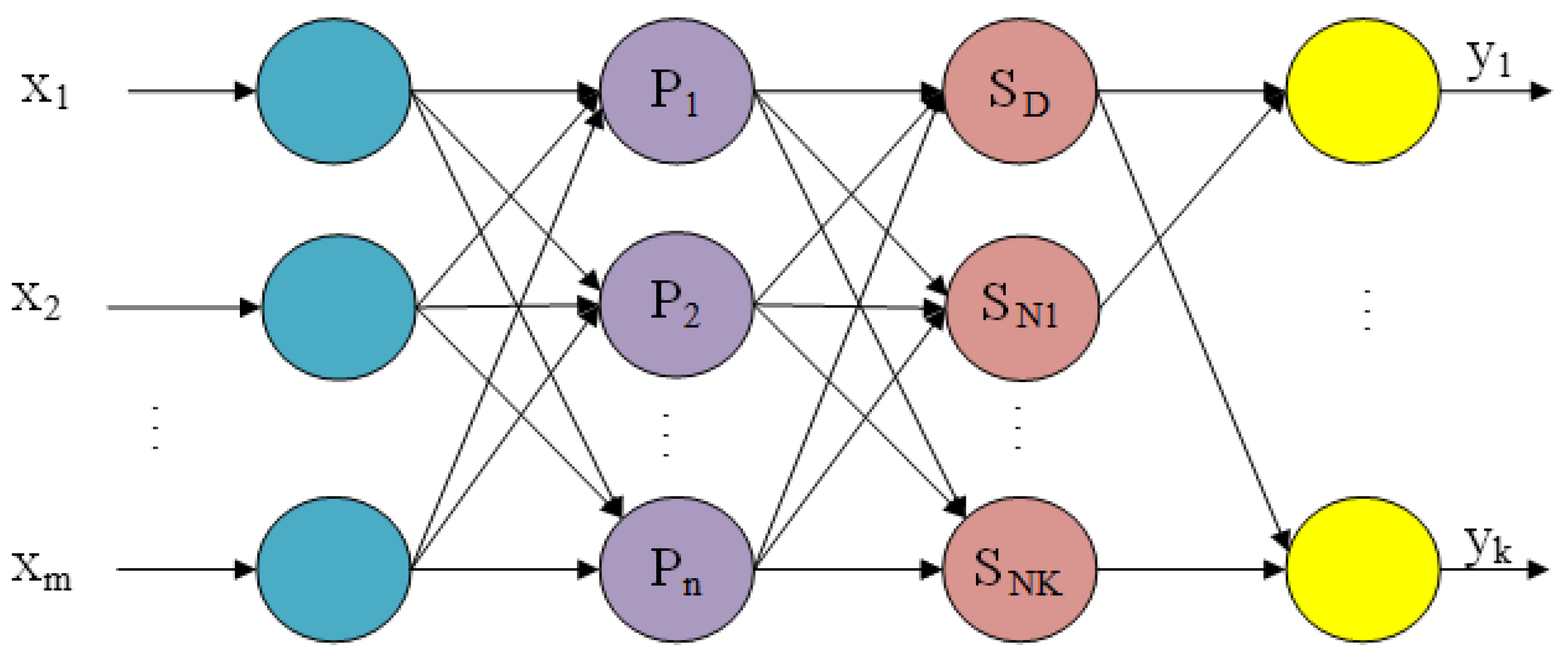
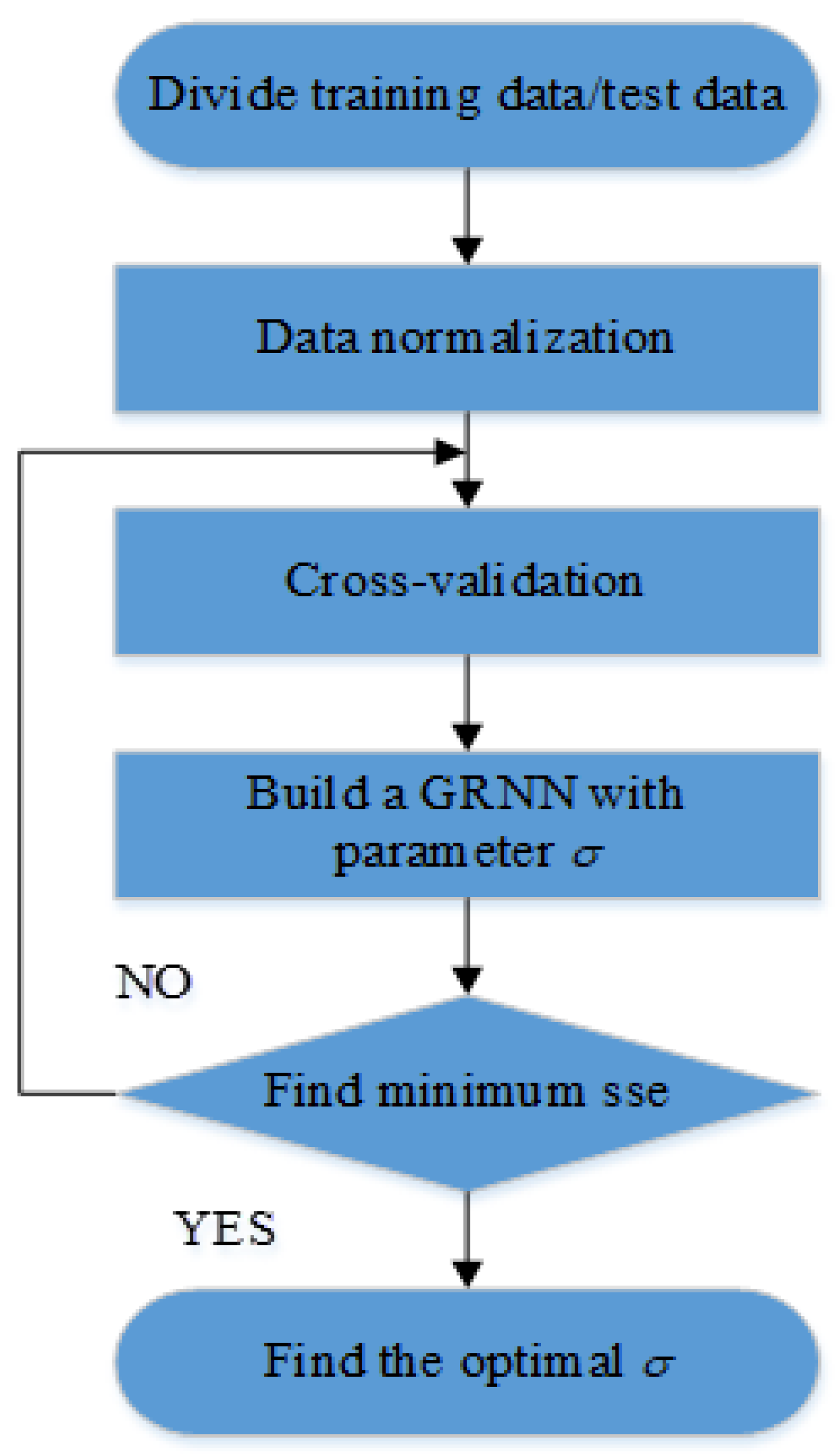
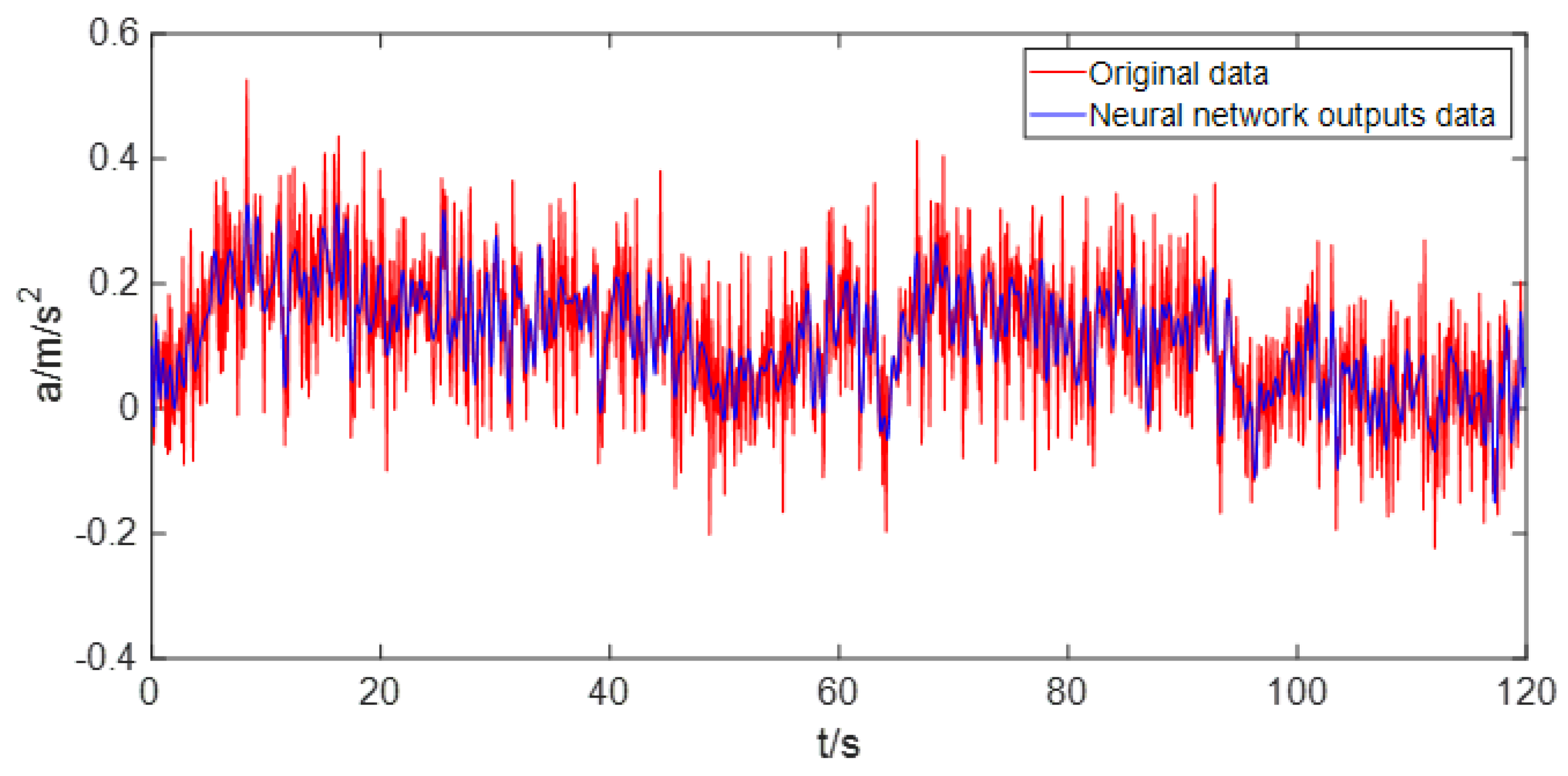
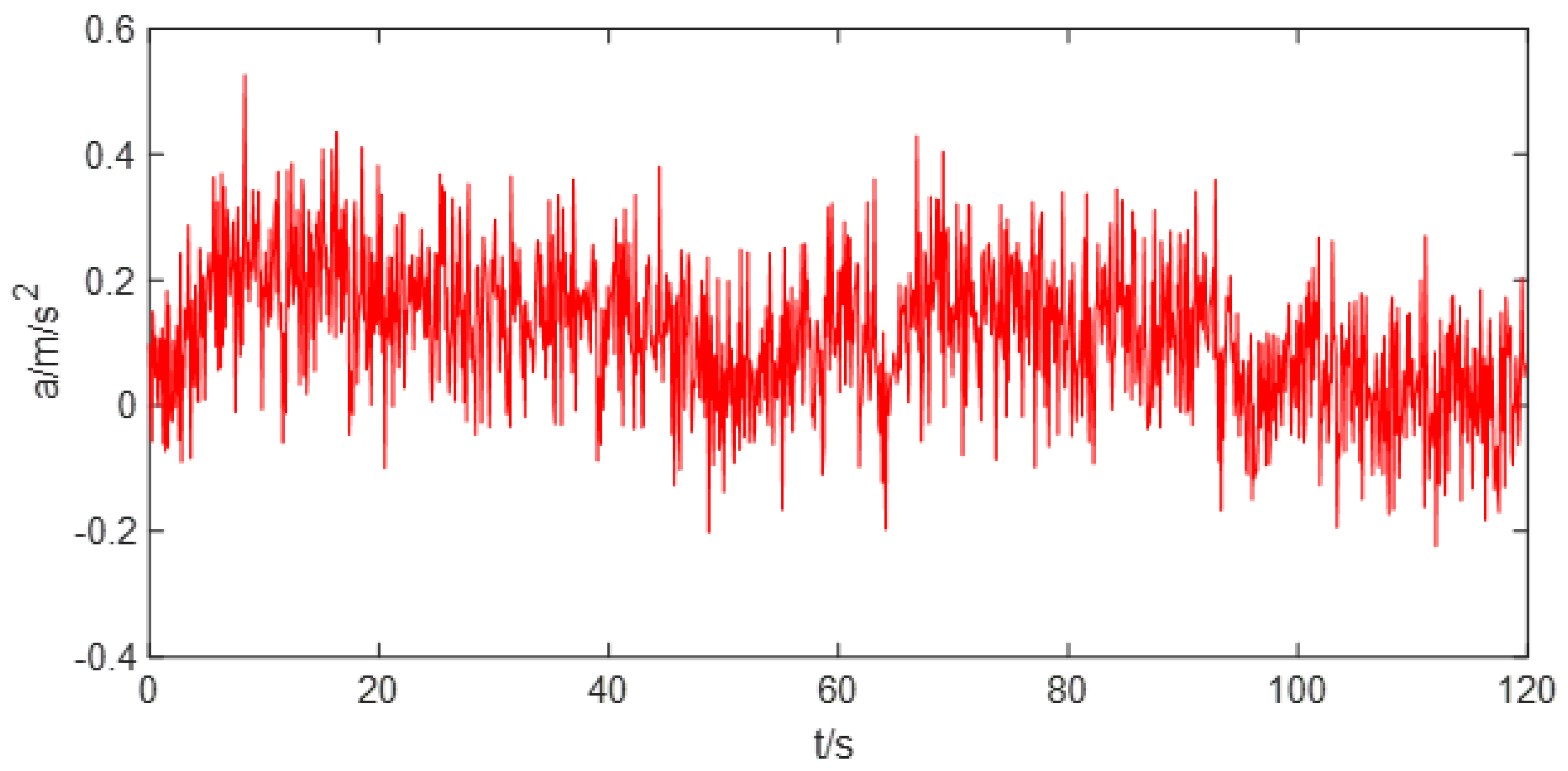
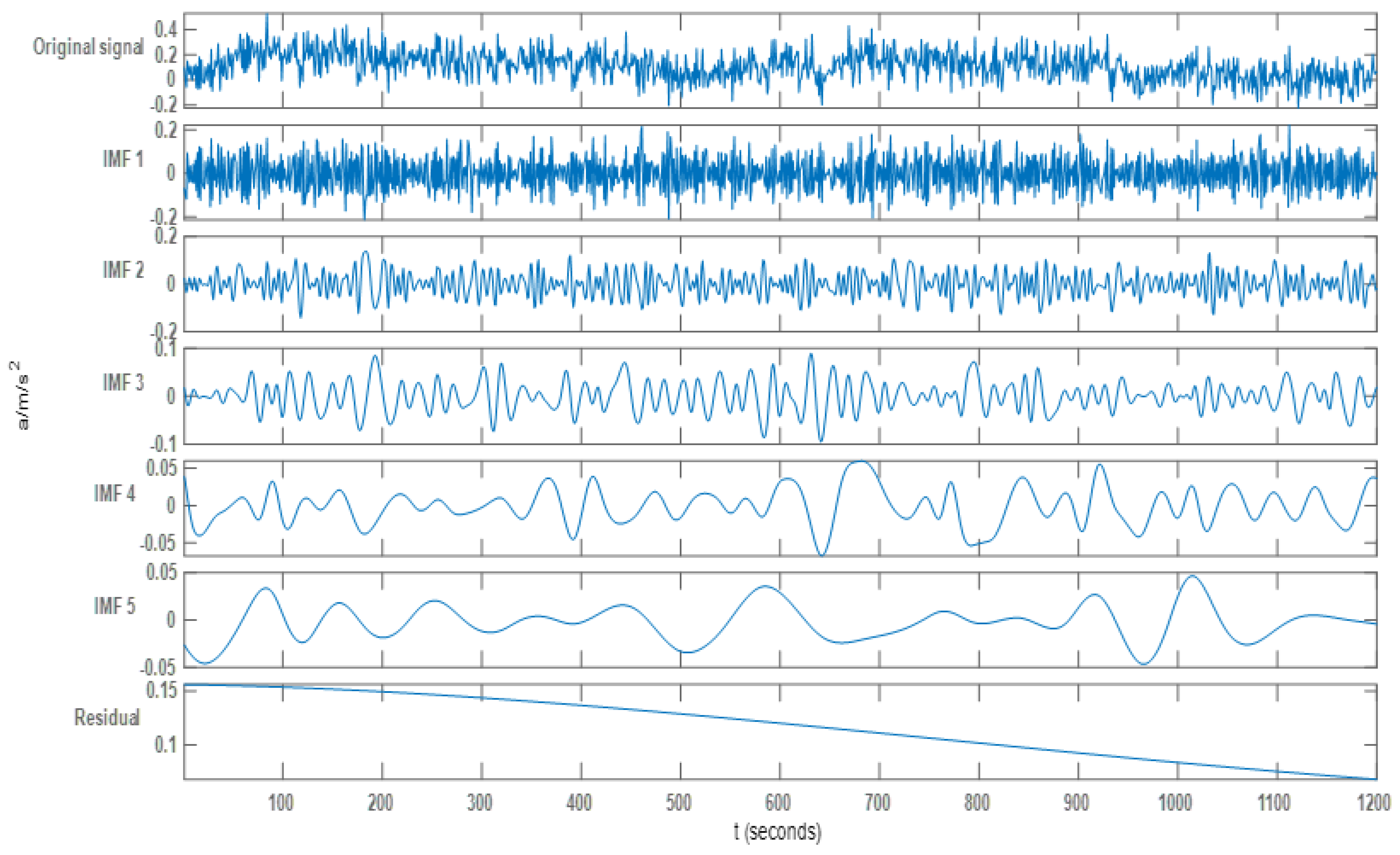
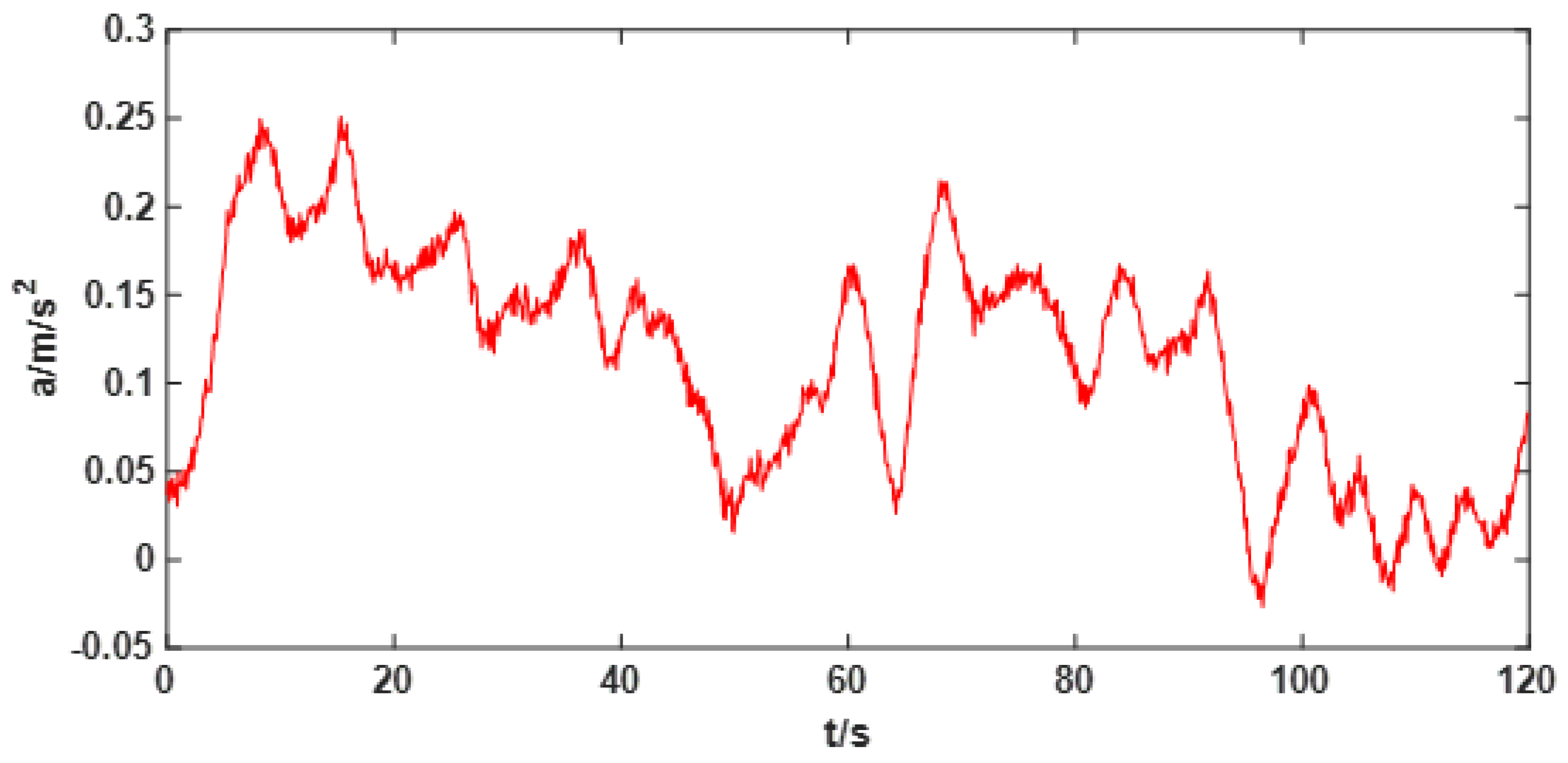

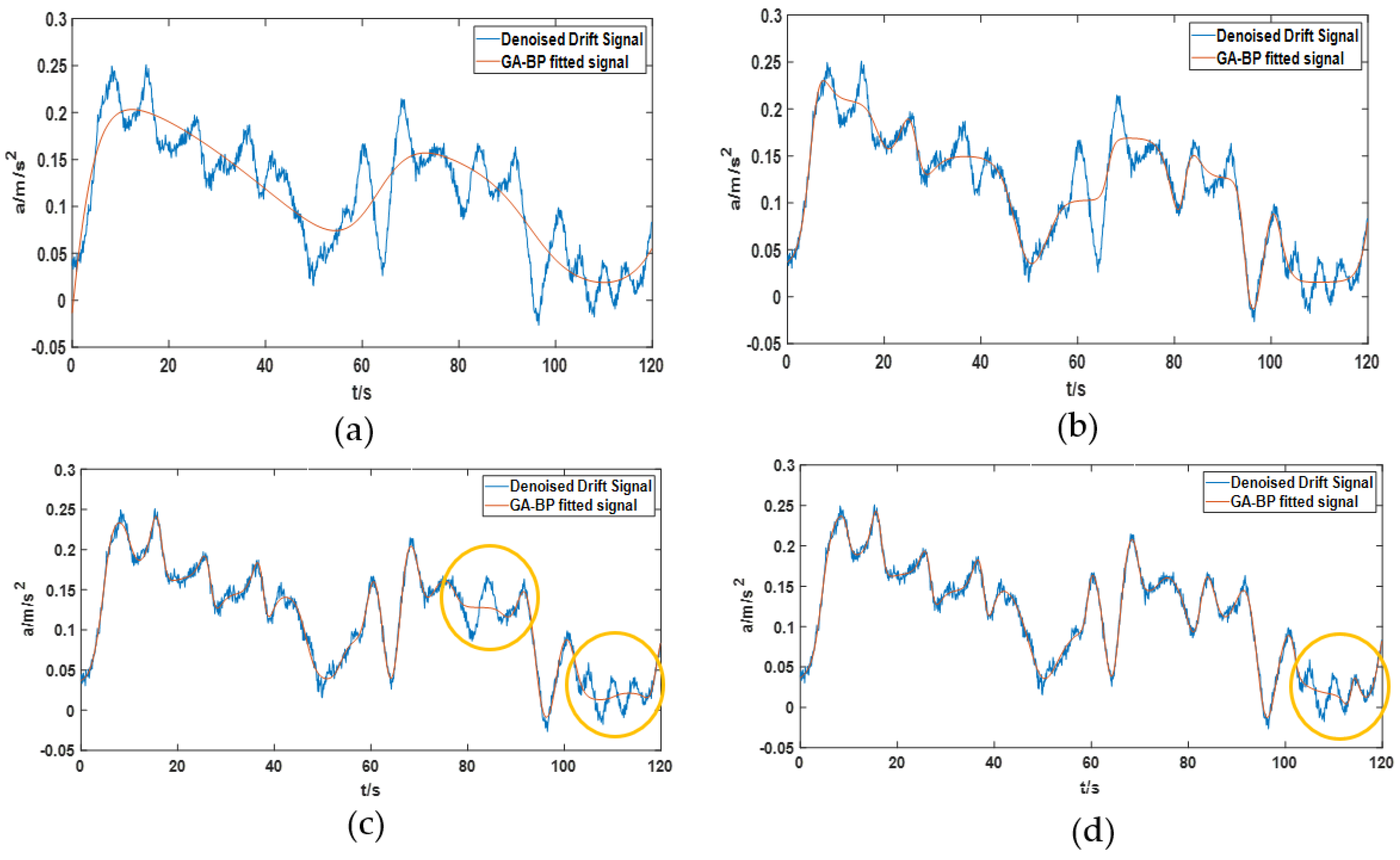
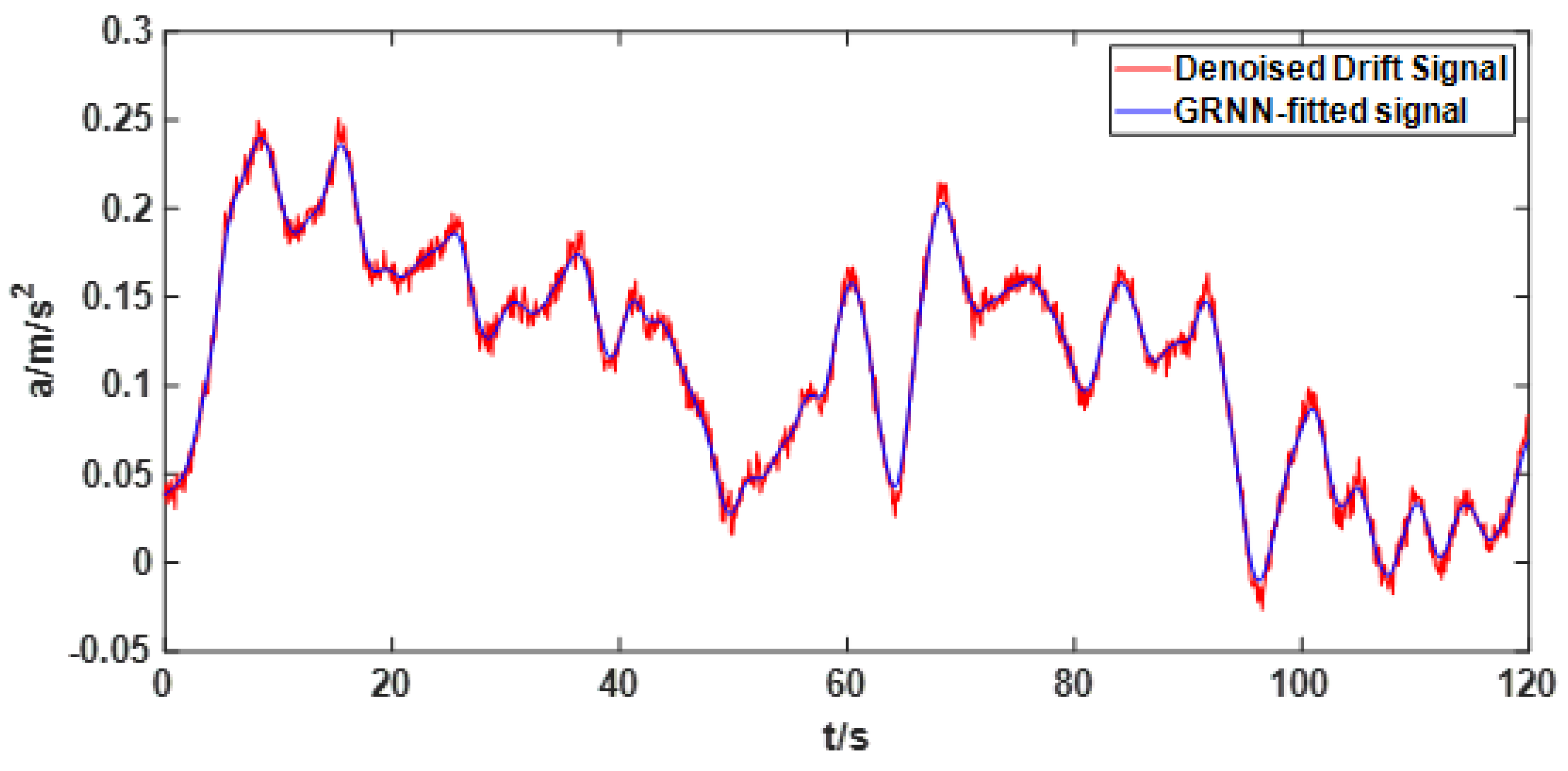
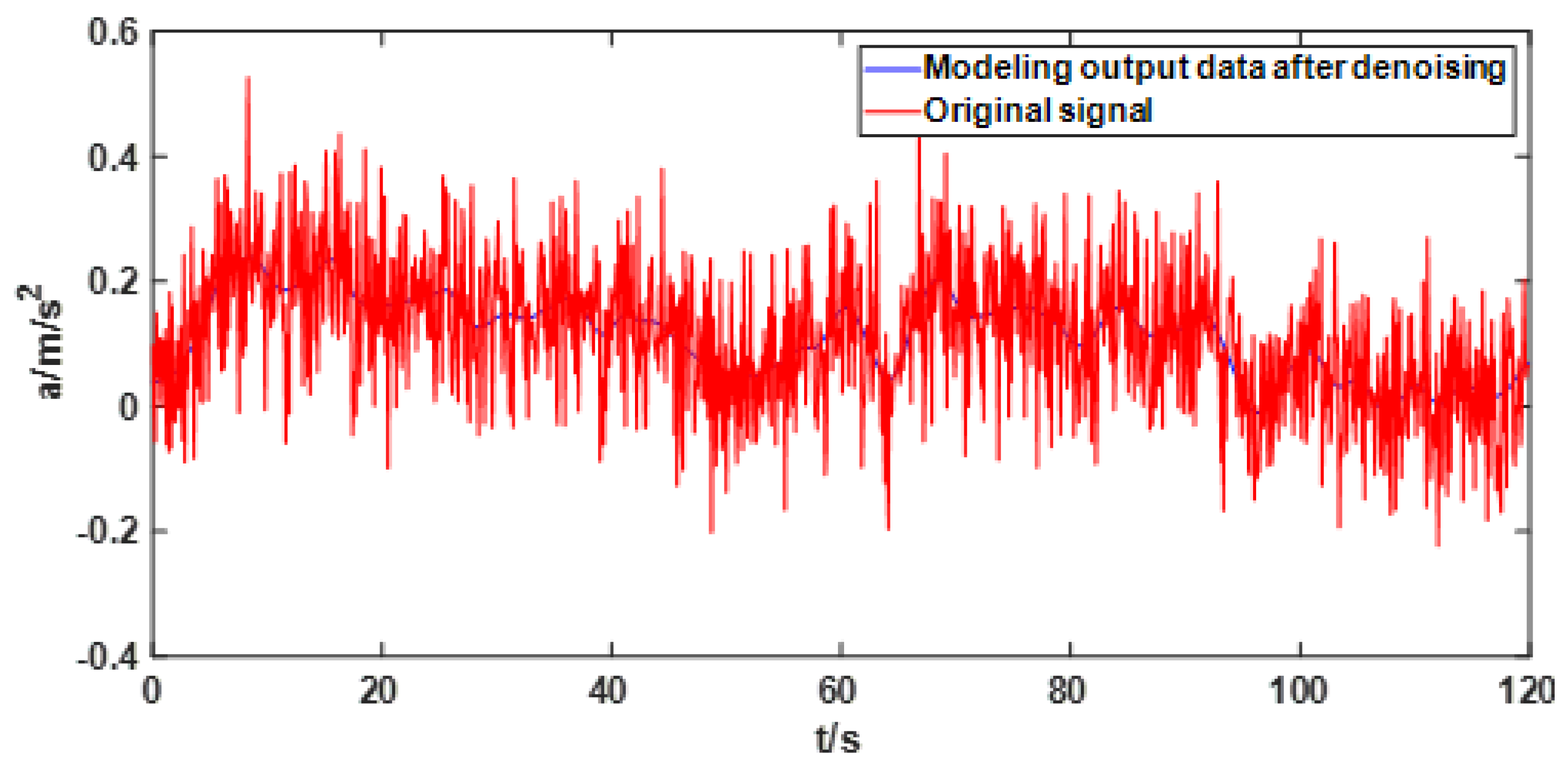
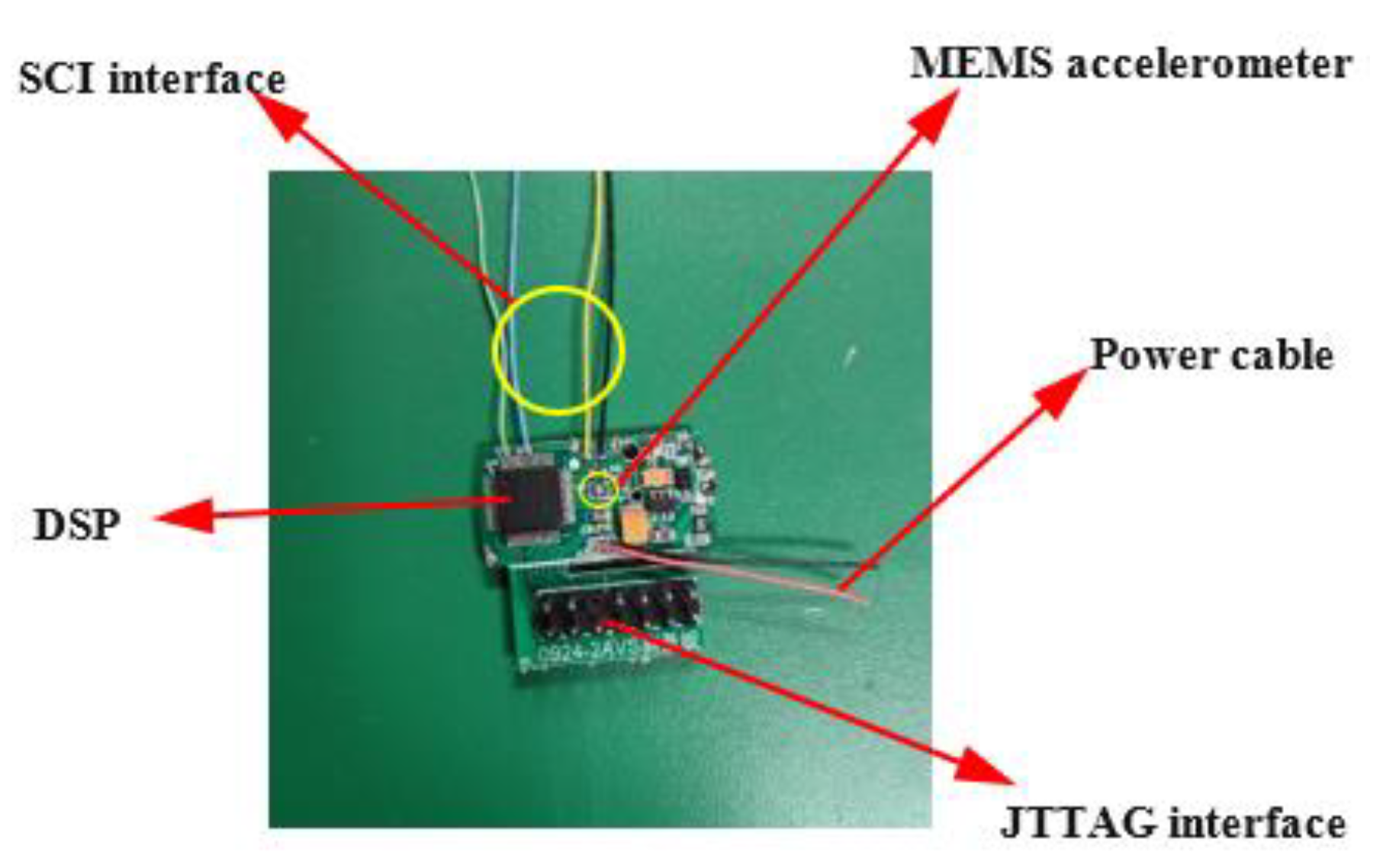
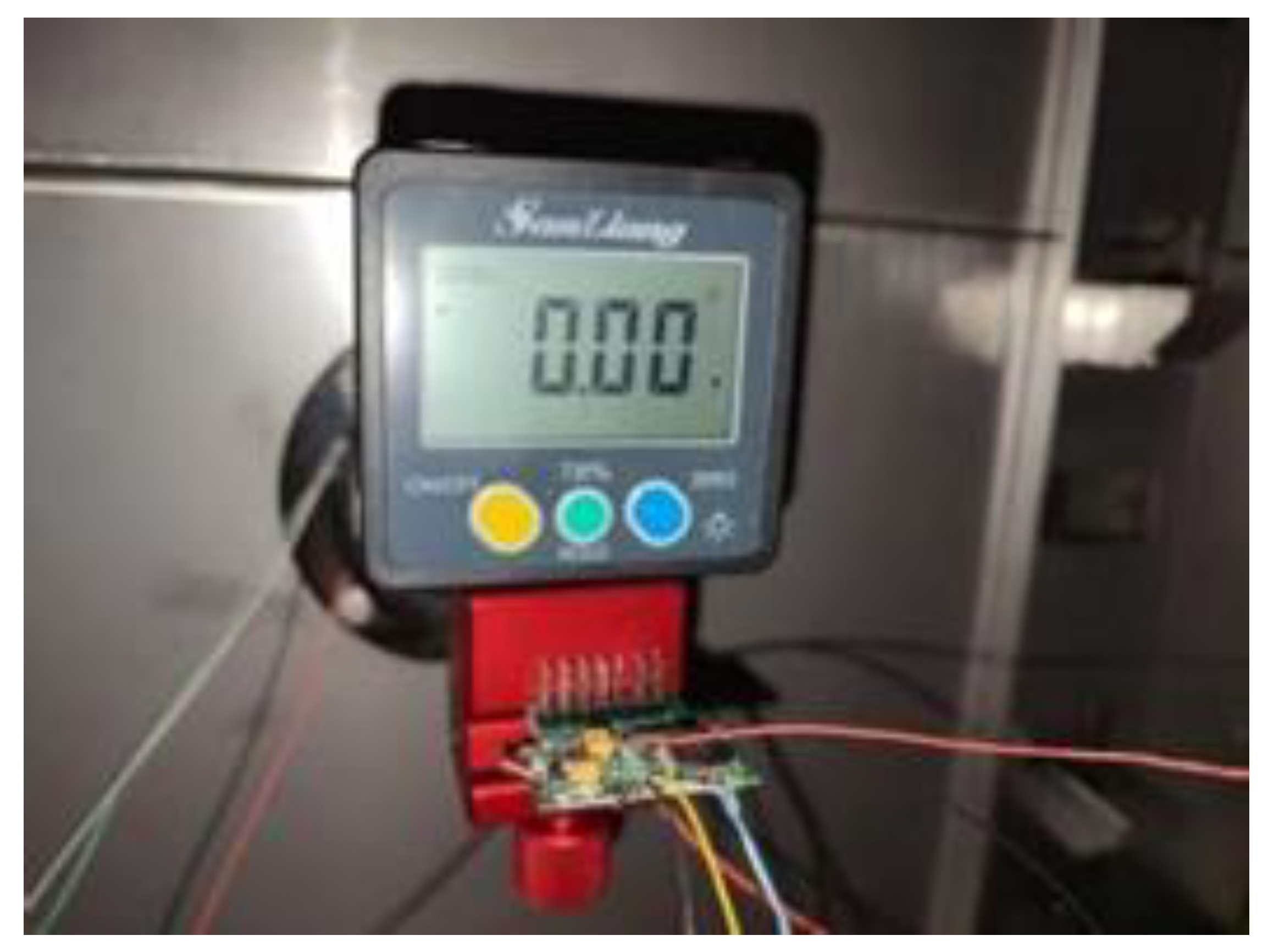
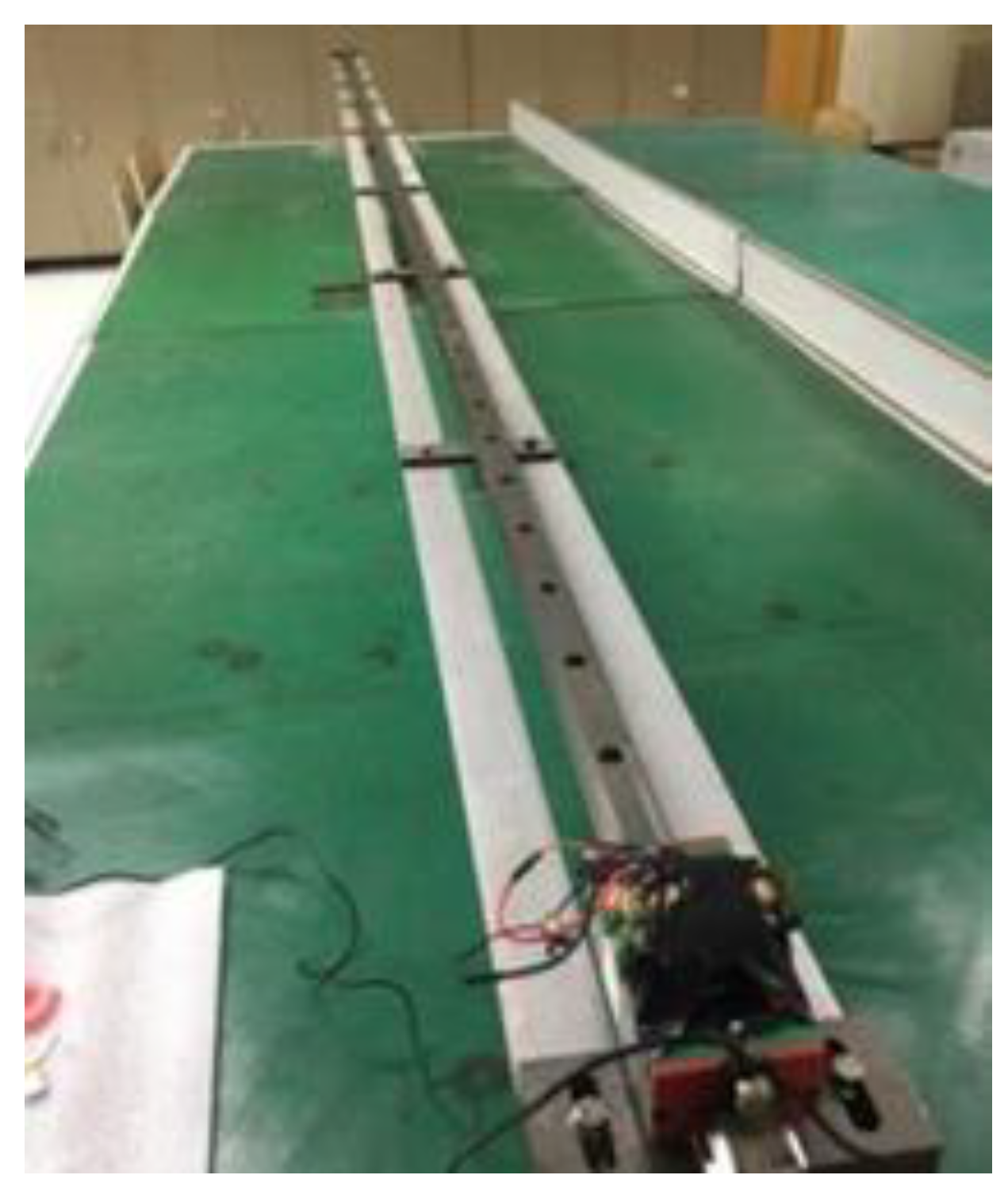
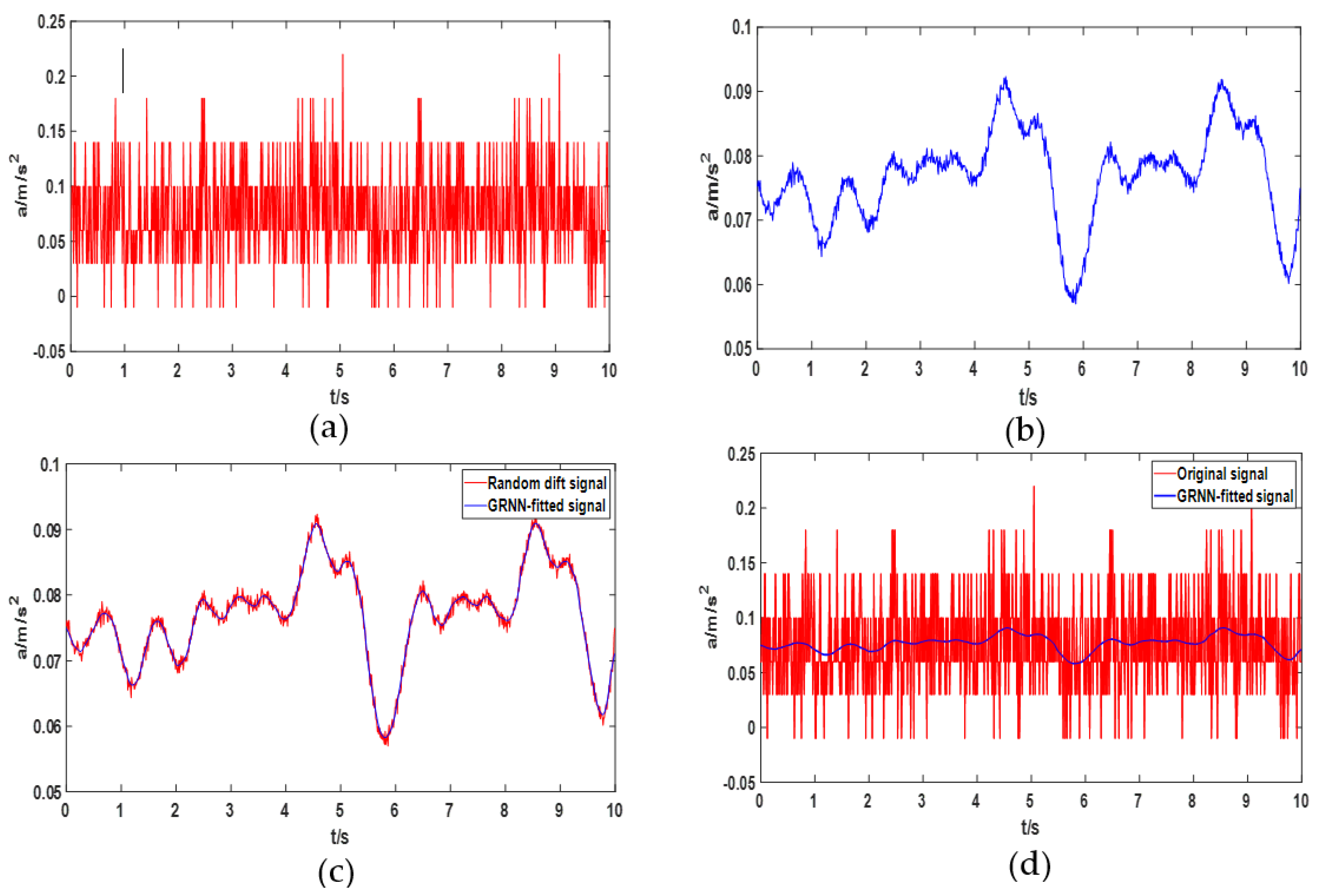
| IMF Component | Average Period | Number of Peaks | Multiple |
|---|---|---|---|
| IMF1 | 2.69 | 446 | 1.00 |
| IMF2 | 5.50 | 218 | 2.04 |
| IMF3 | 10.81 | 111 | 4.01 |
| IMF4 | 21.81 | 55 | 8.10 |
| IMF5 | 46.15 | 26 | 17.10 |
| IMF6 | 100.00 | 12 | 37.17 |
| IMF7 | 240.00 | 5 | 89.22 |
| IMF8 | 600.00 | 2 | 223.05 |
| IMF9 | 1200.00 | 1 | 446.09 |
| IMF10 | 1200.00 | 1 | 446.09 |
| Method | Mean (m/s2) | Variance (m/s2) | Runtime (s) |
|---|---|---|---|
| Three-layer BPNN with 5 neurons | −6.3801 × 10−4 | 7.2346 × 10−4 | 0.3689 |
| Three-layer BPNN with 15 neurons | −2.7316 × 10−4 | 2.4139 × 10−4 | 0.5988 |
| Four-layer BPNN with 25 and 10 neurons | 2.2853 × 10−4 | 7.2478 × 10−4 | 1.1990 |
| Four-layer BPNN with 25 and 25neurons | 1.1045 × 10−4 | 6.9435 × 10−4 | 3.7996 |
| GRNN | −1.2646 × 10−4 | 1.0975 × 10−4 | 0.2567 |
| Actual Displacement | Before Compensation | Measurement Accuracy | After Compensation | Measurement Accuracy |
|---|---|---|---|---|
| 5 m | 5.23 m | 95.4% | 5.10 m | 98% |
| 5 m | 5.20 m | 96% | 5.09 m | 98.2% |
| 5 m | 5.18 m | 96.4% | 5.11 m | 97.8% |
| 5 m | 5.23 m | 95.4% | 5.08 m | 98.4% |
| 5 m | 5.25 m | 95% | 5.12 m | 97.6% |
Publisher’s Note: MDPI stays neutral with regard to jurisdictional claims in published maps and institutional affiliations. |
© 2022 by the authors. Licensee MDPI, Basel, Switzerland. This article is an open access article distributed under the terms and conditions of the Creative Commons Attribution (CC BY) license (https://creativecommons.org/licenses/by/4.0/).
Share and Cite
Shi, Y.; Fang, L.; Xue, Z.; Qi, Z. Research on Random Drift Model Identification and Error Compensation Method of MEMS Sensor Based on EEMD-GRNN. Sensors 2022, 22, 5225. https://doi.org/10.3390/s22145225
Shi Y, Fang L, Xue Z, Qi Z. Research on Random Drift Model Identification and Error Compensation Method of MEMS Sensor Based on EEMD-GRNN. Sensors. 2022; 22(14):5225. https://doi.org/10.3390/s22145225
Chicago/Turabian StyleShi, Yonglei, Liqing Fang, Zhanpu Xue, and Ziyuan Qi. 2022. "Research on Random Drift Model Identification and Error Compensation Method of MEMS Sensor Based on EEMD-GRNN" Sensors 22, no. 14: 5225. https://doi.org/10.3390/s22145225
APA StyleShi, Y., Fang, L., Xue, Z., & Qi, Z. (2022). Research on Random Drift Model Identification and Error Compensation Method of MEMS Sensor Based on EEMD-GRNN. Sensors, 22(14), 5225. https://doi.org/10.3390/s22145225





